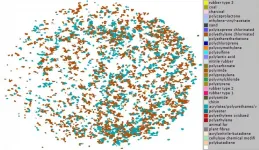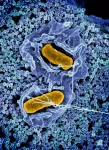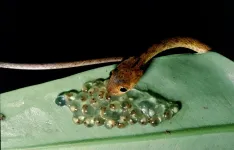Scientists find solution to measure harmful plastic particles in human sewage
2021-05-26
(Press-News.org) Scientists have got up close and personal with human sewage to determine how best to measure hidden and potentially dangerous plastics.
As the way microplastics are measured and counted varies from place to place, there is no agreed understanding of the weight of the problem. Until scientists can agree on one way of measuring them, life on land and sea will continue to ingest who knows how much plastic, affecting health for generations.
A new study, published today in Analytical and Bioanalytical Chemistry, by the University of Portsmouth has examined one method, using a chemical solution called 'Fenton reagent' to remove organic matter from sewage. It found it has significant advantages in processing times and costs over other currently available methods of testing.
Project Lead Dr Fay Couceiro, Senior Research Fellow in Biogeochemistry at the University of Portsmouth, said: "Multiple digestion with Fenton reagent involves mixing the sewage with hydrogen peroxide and iron sulphide multiple times to breakdown the organic matter. When followed by density separation, where you float off the plastics from everything else, it provides a cleaner sample so the size and type of microplastic can be determined with much less interference."
Professor Steve Fletcher, Director of the University's Revolution Plastics initiative, said: "Having some idea of the amount of microplastics in the environment is key to understanding and stopping the potential harmful impacts that this new category of emerging pollutants could have on life on earth. The need for protocols that are robust, simple and reliable together with their standardisation are of crucial importance in the fight against plastic pollution."
The study targeted the detection of microplastics in the sub-hundred-micron size range, which often get missed because of their tiny size, yet they have potentially higher health risks associated with them. This size of particle also has limited data available from previous wastewater research.
To show the value of this method, samples of raw sewage, final effluent and sludge were mixed with two different sizes and types of microplastics. The multiple digestion with Fenton reagent method showed good recovery of the added microplastics. Considering the various stages required for the separation of microplastics, time is a limiting factor in sample processing. The multiple digestion using Fenton reagent is an inexpensive and time-efficient procedure compared to other currently available methods when analysing large numbers of samples.
Dr Couceiro says: "The Fenton reagent method used in this study has huge potential for bringing about a much needed standardistation of the measuring of microplastics. Without being able to compare and contrast concentrations of microplastics, our ability to make significant strides forward in limiting pollution will be restricted. We would welcome further research that could investigate other types of plastics and the recovering of even smaller plastic particles."
INFORMATION:
[Attachments] See images for this press release:

ELSE PRESS RELEASES FROM THIS DATE:
2021-05-26
WHAT:
The immune system's attempt to eliminate Salmonella bacteria from the gastrointestinal (GI) tract instead facilitates colonization of the intestinal tract and fecal shedding, according to National Institutes of Health scientists. The study, published in Cell Host & Microbe, was conducted by National Institute of Allergy and Infectious Diseases (NIAID) scientists at Rocky Mountain Laboratories in Hamilton, Montana.
Salmonella Typhimurium bacteria (hereafter Salmonella) live in the gut and often cause gastroenteritis in people. The Centers for Disease Control and Prevention estimates Salmonella bacteria cause about ...
2021-05-26
The COVID-19 pandemic has seen scientists perform incredible feats in a short amount of time, from developing tests to new types of vaccines. Despite these victories, experts are still working to develop an effective antiviral drug to kill the SARS-CoV-2 virus. A cover story in Chemical & Engineering News, the weekly newsmagazine of the American Chemical Society, details the challenges of and progress toward creating a drug that would help the world conquer COVID-19.
Creating a new antiviral drug is a tricky business. Viruses mutate and replicate quickly, and their structures differ greatly even within the same class, ...
2021-05-26
American writer and humorist Mark Twain, a master of language and noted lecturer, once offered, "The right word may be effective, but no word was ever as effective as a rightly timed pause."
Electric fish and today's TED talk speakers take a page from Twain's playbook. They pause before sharing something particularly meaningful. Pauses also prime the sensory systems to receive new and important information, according to research from Washington University in St. Louis.
"There is an increased response in listeners to words -- or in this case, electrical pulses ...
2021-05-26
It's well known that reptiles depend on temperature cues while in the egg to determine a hatchling's sex. Now, researchers writing in the journal Trends in Ecology & Evolution on May 26 say that embryos of many different animal species also rely on acoustic signals in important ways. They call this phenomenon "acoustic developmental programming."
"Acoustic developmental programming occurs when a sound informs embryos about the environment they'll encounter postnatally and changes their development to better suit this environment," said Mylene Mariette (@MyleneMariette) of Deakin University in Australia.
Because this is a newly discovered phenomenon, the evidence is just beginning to accumulate. And, yet, it seems to ...
2021-05-26
Skokie, IL - The International Society for Stem Cell Research (ISSCR), today released updated guidelines for stem cell research and its translation to medicine. The update reflects emerging advances including, stem cell-based embryo models, human embryo research, chimeras, organoids, and genome editing.
"The 2021 update presents practical advice for oversight of research posing unique scientific and ethical issues for researchers and the public," said Robin Lovell-Badge, PhD, FRS, Chair, ISSCR Guidelines task force and Senior Group Leader and Head of the Division of Stem Cell Biology and Developmental Genetics at The Francis Crick Institute, UK. "They provide confidence to researchers, clinicians, and the public ...
2021-05-26
The multifunctional porous solids with diverse functionalized linkers have been utilized as promising materials for various applications in energy, environmental and biomedical areas. Although their emerging properties are ascribed to varying pore types resulting from combinations of functional groups, the chemical environment of the pores remains an open question. A new synthetic platform where the population of pores can be identified and further controlled is of great interest in materials science.
A research team, led by Professor Wonyoung Choe and Professor Tae-Hyuk Kwon in Department of Chemistry ...
2021-05-26
Communities benefit from sharing knowledge and experience among their members. Following a similar principle - called "swarm learning" - an international research team has trained artificial intelligence algorithms to detect blood cancer, lung diseases and COVID-19 in data stored in a decentralized fashion. This approach has advantage over conventional methods since it inherently provides privacy preservation technologies, which facilitates cross-site analysis of scientific data. Swarm learning could thus significantly promote and accelerate collaboration and information exchange in research, especially in the field of medicine. Experts from the DZNE, the University of Bonn, the information technology company Hewlett Packard Enterprise (HPE) and other research institutions report on ...
2021-05-26
New research published in Nature provides a powerful yet surprisingly simple way to determine the number of visitors to any location in a city.
Scientists* from the Santa Fe Institute, MIT, and ETH Zürich have discovered and developed a scaling law that governs the number of visitors to any location based on how far they are traveling and how often they are visiting. The visitation law opens up unprecedented possibilities for accurately predicting flows between locations, which could ultimately have applications in everything from city planning to preventing the spread of the next major pandemic.
"Imagine you are standing on a busy plaza, say in Boston, and you see people coming and going. This ...
2021-05-26
What The Study Did: This study included data from more than 11,000 emergency medical services (EMS) agencies in 49 states to describe racial/ethnic, social and geographic changes in EMS-observed overdose-associated cardiac arrests during the COVID-19 pandemic through 2020 in the United States.
Authors: Joseph Friedman, M.P.H., of the University of California, Los Angeles, is the corresponding author.
To access the embargoed study: Visit our For The Media website at this link https://media.jamanetwork.com/
(10.1001/jamapsychiatry.2021.0967)
Editor's Note: The article includes funding/support disclosures. Please see the article for additional information, including other authors, author ...
2021-05-26
What The Study Did: Researchers conducted a review of studies examining the frequency and variety of persistent symptoms after COVID-19 infection.
Authors: Steven N. Goodman, M.D., M.H.S., Ph.D., of Stanford University in Stanford, California, is the corresponding author.
To access the embargoed study: Visit our For The Media website at this link https://media.jamanetwork.com/
(doi:10.1001/jamanetworkopen.2021.11417)
Editor's Note: Please see the article for additional information, including other authors, author contributions and affiliations, conflict of interest and financial disclosures, and funding and support.
INFORMATION:
Media ...
LAST 30 PRESS RELEASES:
[Press-News.org] Scientists find solution to measure harmful plastic particles in human sewage




